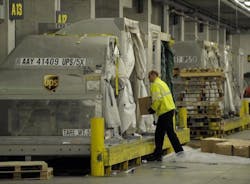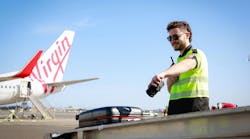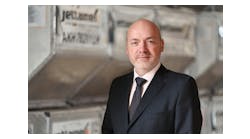The call came into the London Metropolitan Police bomb squad in the early hours of the morning. Isolated at the East Midlands airport in central England was a UPS package dispatched from Yemen, containing a laser printer that Saudi intelligence believed had been converted into a bomb.
Before dawn a bomb squad arrived on the scene. The plane had been cleared and left at 4:20 am, without the package identified by its waybill number as the laser printer. Officers inspected the printer and lifted out the ink cartridge but found no explosive device. According to security sources, they also brought in specially trained dogs and passed the printer through an X-ray scanner, but those, too, failed to locate any explosives.
The security cordon around the area where the laser printer had been isolated was lifted. But Saudi counter-terrorism officials implored British authorities to re-examine the printer. When they did, they found 400 grams of the high-explosive PETN inside the ink cartridge.
The bomb had been timed to explode hours earlier. But the bomb squad had inadvertently defused the device earlier when they had lifted the printer cartridge out of the printer, disconnecting the explosives from the timer.
A similar drama had been playing out at an airport in Dubai in the United Arab Emirates, where another printer bomb had been located that same day. These were some of the most sophisticated explosive devices ever seen from al Qaeda.
These discoveries on October 29, 2010, sent shock waves through Western capitals. Not only had these bombs gone through screenings at several airports without being detected, they also had traveled on passenger jets during the first legs of their journeys.
And most disturbing of all: For many hours, the explosives went undetected by bomb experts in two countries, despite being right in front of them.
A few weeks after the incident, U.S. Senator Susan Collins asked Transportation Security Administration chief John Pistole whether the bombs would have been detected by the country's current security system.
"In my professional opinion, no," Pistole replied.
The group that claimed responsibility for the plot -- the Yemen-based al Qaeda in the Arabian Peninsula -- appeared to have found the Achilles heel of international aviation.
While much airport security is concentrated on screening passengers and their checked bags, about half the hold on a typical passenger flight is filled with cargo. In fact, over a third of cargo by volume that entered the United States in 2010 was shipped on passenger jets, according to the Department of Transportation. That is 3.7 billion tons. Another 7.2 billion tons of air cargo came in on all-cargo aircraft, according to the DOT.
And the screening requirements for such cargo are not as strict as they are for passengers and their checked bags.
If it took authorities in Britain and Dubai hours to identify a bomb that was right in front of them, what are the chances of finding such devices amid the millions of tons of air cargo flying into the United States each day?
A difficult quandary
U.S. authorities were already aware of the potential for terrorists to take advantage of lax cargo security. A law that required screening for all cargo on domestic and inbound international passenger flights had taken effect two months before the printer bomb scare.
While the Transportation Security Administration was able to ensure the screening of all domestic cargo, it fell short when it came to screening all inbound international cargo, according to the U.S. Government Accountability Office.
So the TSA announced that the 100% requirement would be brought into effect for inbound flights by January 2012. Now, the TSA has indefinitely deferred this goal in favor of a risk-based approach, according to Massachusetts Rep. Ed Markey.
Following the 2010 bomb plot, the United States and its international partners took a number of steps to bolster air cargo security. They banned cargo shipments assessed as too high a risk that originated from or transited through Yemen and Somalia. U.S. authorities implemented enhanced screening for passenger jet cargo assessed as having an elevated risk and tightened procedures for incoming mail. Those requirements have not been made public. The Department of Homeland Security brought in enhanced screening for U.S.-bound shipments on all-cargo aircraft.
While industry insiders say progress has been made, some lawmakers on Capitol Hill express concern about any approach that doesn't involve the screening of all cargo.
"The low-risk cargo does not receive anywhere near the level of security as the high-risk cargo," said Markey, who co-authored legislation mandating screening on passenger jets by August 2010.
"There is no such thing as low-risk cargo because, in the hands of al Qaeda, that cargo becomes high risk."
But some of those on the frontlines of air cargo security point out that the risk-based approach stems from on-the-ground realities.
"Identifying high-risk cargo wherever it is in the supply chain and singling it out for physical screening is the better approach to securing cargo on an international scale," said David Brooks, the head of American Airlines air cargo.
And the industry says TSA mandates are not easy to enforce when they involve other countries that may face logistical challenges in conforming to U.S. inspection standards. Economic factors also played a role in the U.S government's delay in imposing 100% inbound screening.
It was a quandary that al Qaeda exploited. "(Our goal was to) force upon the West two choices: You either spend billions of dollars to inspect each and every package in the world or you do nothing and we keep trying again," al Qaeda in the Arabian Peninsula announced after the package bomb plot.
New technology
Even if 100% of all plane cargo is screened, it's no panacea for keeping bombs off airplanes.
Single-view X-ray machines -- the technology still used at a significant number of air cargo warehouses around the world -- lack the resolution to thoroughly vet the contents of shipments, according to industry insiders. The machines find it difficult to distinguish PETN from similar powdered substances, explosive detection experts told CNN.
It was a weakness that al Qaeda exploited in the printer bomb plot by filling the ink cartridges with PETN.
"The toner cartridge contains the toner which is carbon based and that is an organic material. The carbon's molecular structure is close to that of PETN," AQAP boasted after the attempted attack.
Under TSA guidelines, cargo screening can involve a variety of methods including physical inspection, dogs, a variety of single-view or multiview X-ray machines, and "explosive trace detection" -- which involves running a hand-held device over the surface or insides of a package, which "sniffs" the air for minute quantities of explosive.
Dogs also are used to sniff for bombs, but for years, TSA officials have had reservations about relying on canine teams to screen for explosives. According to explosive detection experts, PETN in particular is difficult for sniffer dogs to detect, because very little of it disperses into the air.
Physical inspection of every package is impractical given the volume of cargo and the ease with which PETN can be hidden.
In order to keep one step ahead of the terrorists, airlines and air cargo handlers are investing millions of dollars in the latest generation of advanced X-ray machines and explosive trace detection.
"PETN can be found quite easily in very small amounts using trace detection equipment and in bulk form by (advanced) X-ray machines," said Kevin Riordan, technical director at Smiths Detection, a British company that is one of the leading producers of explosive detection equipment.
If the British bomb squad at East Midlands airport had such equipment, they would have been able to see the PETN inside the printer cartridge, according to another UK detection expert.
But Riordan conceded that even if authorities had the latest equipment, al Qaeda could take steps to make detection more difficult.
"We'd have to say there is always a way through," he told CNN. "The risk is never removed totally."
Air cargo industry insiders say that combining several layers of screening is the best protection against future al Qaeda bomb plots. And all those interviewed by CNN stressed the critical role of intelligence.
"There is no 100%, foolproof system for all cargo," U.S. Homeland Security Secretary Janet Napolitano told CNN, "but what we can do and are doing is maximizing our ability to prevent such a plot from succeeding.
That included "good intel, good information sharing."
A unique challenge
The new generation of multiview X-ray machines and explosive detection equipment is now routinely used to scan all checked and hand luggage at airports in the United States and Europe, according to explosive detection experts, but not yet all air cargo.
Parts of Africa, the Middle East and Asia are lagging behind in deploying this technology at air cargo departure points, according to air cargo industry insiders. U.S. officials say they've put a high priority on new global standards to plug the technology gap.
"The global supply chain presents some challenges because the weakest link in that global supply chain can adversely affect the security throughout that supply chain," said TSA administrator Pistole.
Scanning air cargo presents unique challenges because a high proportion of it has been consolidated into large pallets by the time it arrives at airports and is ready to be loaded onto planes. TSA has yet to license any technology that can reliably detect explosives within pallets.
In the United States this had led to more than half of cargo screening being conducted at off-airport sites, according to Brandon Fried, executive director of the Air Forwarders Association. The shift towards screening of smaller configurations of cargo at these sites before palletization helped U.S. authorities meet the 100% screening mandate for domestic cargo.
But other parts of the world are lagging behind in adopting such initiatives.
Homeland security experts say the private sector must step up to the plate if air cargo is to be secured.
"The U.S. has policies on how much cargo needs to be screened inbound. We can control that to some degree, but we are very much reliant on our partners," said Robert Liskouski, a former director of infrastructure protection at the Department of Homeland Security.
U.S. flag carriers say they have taken steps to bolster cargo security since the package bomb plot. In April 2011, TSA air cargo security chief Doug Brittin told the International Air Cargo Association that airlines were screening 80% of inbound air cargo and some U.S. flag carriers as much as 95%.
After missing the August 2010 deadline, the United States has yet to set a new timeline to implement the 100% screening mandate for inbound cargo flights, according to a letter from TSA's Pistole to U.S. legislators in December 2011. But he said he expects to meet that goal no later than 2013.
Industry insiders hope a voluntary pilot program called Air Cargo Advance Screening, in which airlines send manifest data to U.S. Customs and Border Protection several hours before departure, will further bolster inbound screening. But U.S. authorities say challenges lie ahead in bringing the program fully on stream.
Despite last year's elimination of al Qaeda chief Osama bin Laden, the threat from the terrorist group still remains a major concern. Recent months have seen AQAP, the group responsible for the 2010 printer bomb plot, take advantage of political turmoil in Yemen to expand its operations. Saudi Arabia's counterterrorism service believes this will bolster the group's ability to target the United States. And it believes Ibrahim al Asiri, the group's master bomb-maker, has trained several apprentices in how to make sophisticated PETN-based bombs.
Markey says that time is not on the United States' side.
"Every day that goes by is another day that al Qaeda might exploit that opening -- and once again successfully terrorize our country," he told CNN.
Copyright 2012 Cable News NetworkAll Rights Reserved






